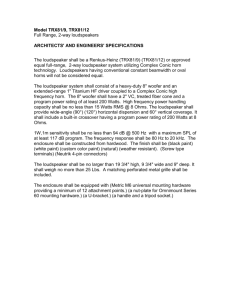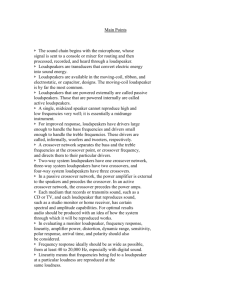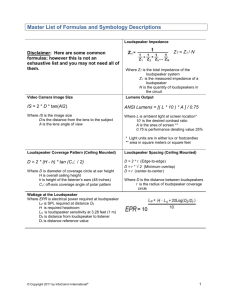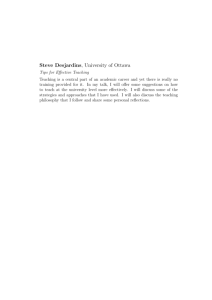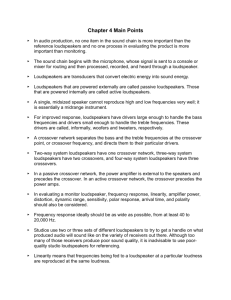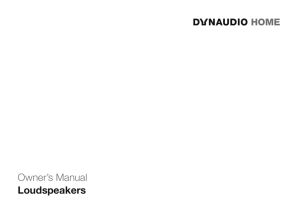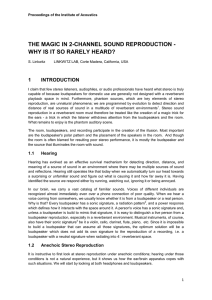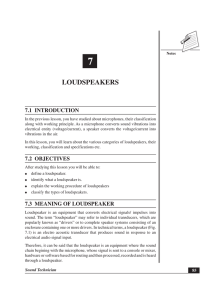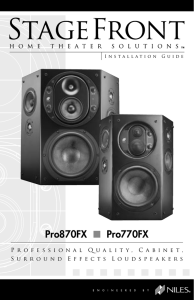Accurate sound reproduction
advertisement
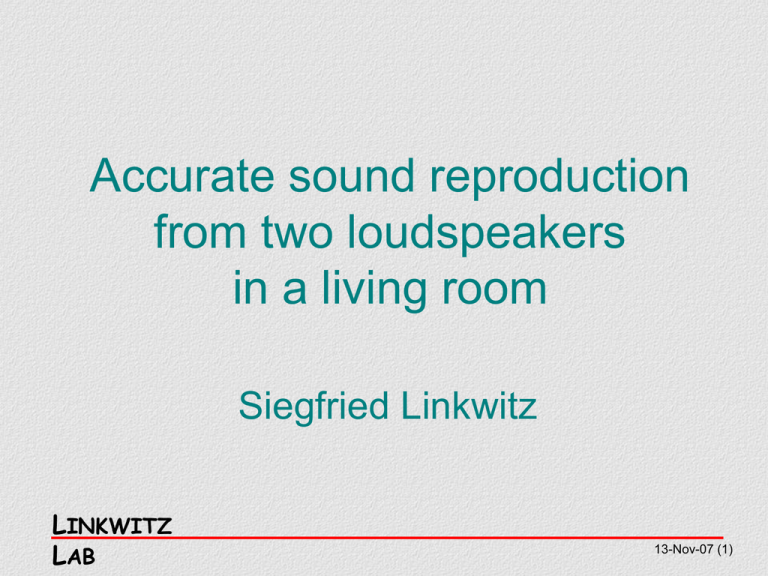
Accurate sound reproduction from two loudspeakers in a living room Siegfried Linkwitz LINKWITZ LAB 13-Nov-07 (1) D M A B Measurement & listening room LINKWITZ LAB 13-Nov-07 (2) Claim #1 Playback of a recording over two loudspeakers can only create an auditory illusion of the original event LINKWITZ LAB 13-Nov-07 (3) Confusing cues must be minimized to strengthen the illusion of “being there” LINKWITZ LAB 13-Nov-07 (4) Confirmed confusing cues from the loudspeakers • On-axis frequency response variations • Resonance / stored energy • Non-linear distortion • Cabinet edge diffraction LINKWITZ LAB 13-Nov-07 (5) Confirmed confusing cues from the room • Modes / Resonances • Reflections Left-right symmetry Delayed vs. direct sound Spectral content Decay rate LINKWITZ LAB 13-Nov-07 (6) Questionable cues from loudspeakers and room • Off-axis frequency response • Floor reflection LINKWITZ LAB 13-Nov-07 (7) Claim #2 To minimize confusing cues from loudspeakers and room requires: • Symmetry of reflections rel. to direct sounds • Delay of reflections >6 ms • Spectrum of reflections = direct sound LINKWITZ LAB 13-Nov-07 (8) Spectrum of reflections = direct sound requires: Frequency-independent polar response • Omni-directional • Bi-directional, dipolar • Cardioid loudspeaker Frequency-independent room surface attenuation/diffusion LINKWITZ LAB 13-Nov-07 (9) Symmetry and delay of reflections requires rooms with: • Symmetrical loudspeaker-listener setup • Loudspeakers >1 m from large surfaces LINKWITZ LAB 13-Nov-07 (10) Room-Loudspeaker-Listener layout LINKWITZ LAB 13-Nov-07 (11) D M A B Measurement & listening room LINKWITZ LAB 13-Nov-07 (12) Two types of loudspeakers LINKWITZ LAB 13-Nov-07 (13) Left speaker Room response at A Dipole Dipole Monopole LINKWITZ LAB Right speaker Monopole from 200 ms impulse response time record 13-Nov-07 (14) Room reflections and their measurement LINKWITZ LAB Tone burst test signal 13-Nov-07 (15) 3 kHz burst response at A during 50 ms LINKWITZ LAB 13-Nov07 (16) Power spectrum during 50 ms of 3 kHz burst LINKWITZ LAB 13-Nov-07 (17) OBSERVATION The dipolar and monopolar loudspeakers sound almost identical in spectral balance and clarity despite their differences in measured room response and burst response. Phantom imaging is very similar, precise, but with greater depth for the dipole. Loudspeakers and room “disappear” LINKWITZ LAB 13-Nov-07 (18) HOW IS THIS POSSIBLE? Sound stream segregation & integration from onset, timbre, duration, loudness, direction, distance cues Our perceptual “acoustic horizon” is variable and adapts by attention “This is your brain on music”, Levitin, 2006 “Spaces speak, are you listening?” Blesser & Salter, 2007 “Auditory scene analysis”, Bregman, 1990 LINKWITZ LAB 13-Nov-07 (19) EVOLUTION OF SPATIAL HEARING Adaptation to the different acoustic properties of forest and savanna Survival by attention to cues for direction and distance of a threat Ignoring stationary, non-threatening sounds Adaptation to listening in modern closed spaces LINKWITZ LAB 13-Nov-07 (20) THE PRECEDENCE EFFECT IN A ROOM Localization Direct and reflected sound are heard as a single entity from the location of the direct sound. The Haas effect Integration of a direct sound with a delayed sound adding loudness De-reverberation We are not normally much aware of reverberated sound even when its energy is larger than that of the direct sound LINKWITZ LAB William M. Hartmann, 1997 13-Nov-07 (21) Guenther Theile’s Association Model LINKWITZ LAB Perception of Reproduced Sound 1987 13-Nov-07 (22) Two-channel playback in a normal living space can provide an experience that is fully satisfying. Loudspeakers and room disappear and the illusion of listening into a different space takes over. LINKWITZ LAB 13-Nov-07 (23) Omni-directional loudspeaker design issues Driver size/l Xmax LINKWITZ LAB 13-Nov-07 (24) Monopole - Dipole LINKWITZ LAB 13-Nov-07 (25) Baffle size/l Dipole loudspeaker design issues Xmax LINKWITZ LAB 13-Nov-07 (26) Building a cardioid loudspeaker 1 - Summation of coincident omni source and dipole source C = 1/2 + 1/2 cos(a) 2 - Gradient loudspeaker Summation of two spaced omni sources, one delayed electrically by T = d/c 3 - Resistance box Rear wave delayed by acoustic RC lowpass filter T = 2/RC = d/c with R = 411 Ns/m3 Benefits? LINKWITZ LAB 13-Nov-07 (27) Claim #2 Polar response - Spectrum of reflections Loudspeaker placement - Delay of reflections and current practices • Loudspeaker construction • Loudspeaker setup • Room treatment materials • Room equalization methods • Recording techniques LINKWITZ LAB 13-Nov-07 (28) Two-channel Stereo vs. Surround sound What am I missing? • Complete Envelopment What am I gaining? • Believability • Satisfaction • Simplicity LINKWITZ LAB 13-Nov-07 (29) Thank you for your attention Questions? LINKWITZ LAB 13-Nov-07 (30) Rear tweeter contribution to dipole loudspeaker D Frequency response LINKWITZ LAB Reflections 5-10-07 (12) 3 kHz burst response at B during 400 ms LINKWITZ LAB 5-10-07 (15) Rectified burst response of D at location A for different frequencies during 100 ms LINKWITZ LAB 5-10-07 (16) HYPOTHESIS Confusing cues from the room are minimized if the reflections are: (1) Left-right symmetrical (2) Delayed >6 ms (3) Attenuated copies of the direct sound in spectral content LINKWITZ LAB 5-10-07 (18) Impediments to creating a realistic impression of an acoustic event • Inadequate polar response of typical box loudspeaker designs • Insufficient dynamic range of the loudspeakers • Loudspeaker placement too close and non-symmetrical to the room walls • Room treatment with absorbers and diffusers which change the spectral content of reflections • Electronic room equalization above bass frequencies • Recordings with too many microphones and in separated spaces LINKWITZ LAB 5-10-07 (21)
